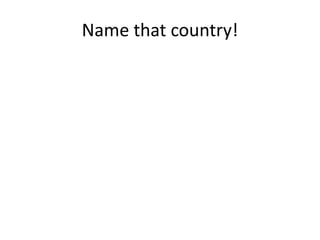
L4 ap economic groupings
- 2. Name the country – BLANKTY BLANK 2 3 1 4 5 8 96 7 10
- 5. How useful? • How useful is the Brandt line? • Why do we still look at it and use it? • What are the problems with it
- 6. Limitations with the Brandt Line • Limited MEDC / LEDC view of world. • Only focuses on the economic. What about all the subsistence farmers in African nations? • Many emerging economies ‘in the middle’. These have been poor in the past and are now relatively wealthy. E.g. Brazil
- 8. Limitations with the Core, Semi Periphery and periphery model • Better but still quite simplistic. • Based in economic involvement. • The development of rich elite in some cities is still not recognised e.g. Super rich in cities like Beijing.
- 9. Is there a better measure of development? • The Human development index (HDI) is based on 3 main criteria (a composite); – GNP per person – Life expectancy – Educational attainment (adult literacy & average number leaving school) • World rankings here
- 11. Mix and Match Key Terms The difference in levels of economic and social well-being between the richest and poorest nations. A measure of the financial value of all the goods and services produced in a territory (can be per person as well as well) A composite of three development factors; income per capita (person), life expectancy and adult literacy rate A lack of wealth. Poverty Human development Index Gross domestic produce Development Gap
- 12. Global Wealth 2002 Global Wealth 2015 Global Wealth Growth Global Wealth Decline Worldmapper Maps
- 13. 1. Economic Groupings (p99) 1. Least Developed Countries 2. Newly Industrialised Countries 3. Ex-Soviet states 4. Organisation of petroleum exporting countries 5. Organisation for economic cooperation and development.
- 14. 1. Least Developed Countries
- 15. 2. Newly Industrialised Countries
- 17. 4. OPEC
- 18. 5. OECD
- 19. – In the world’s 50 poorest countries, average income is around $0.80 per day. – About 60% of the poorest countries experienced civil conflict between 1990 and 2001. – The gap between the richest and the poorest nations has grown. – Initiatives such as fair trade are designed to ensure that people in the least developed countries gain a better share of global wealth. – Animation here Global Wealth
- 20. 1. Economic Groupings In the past it was simple… Economic development was the basis for dividing the world’s 193 countries GDP (gross domestic product ) and the Human Development Index (HDI). The World Bank uses per capita Gross National Income (GNI) as the basis of its classification. Using the World Bank classification, the world was broadly divided into two categories — ‘developed’ and ‘developing’. However, such an approach no longer works well.
- 21. 2. Political Groupings Countries, usually at similar development levels and in the same part of the world, agree to form trade blocs by signing international agreements. These allow for tariff- and quota-free trade. The World Trade Organization works to increase free trade between blocs.